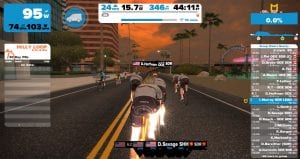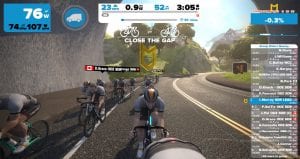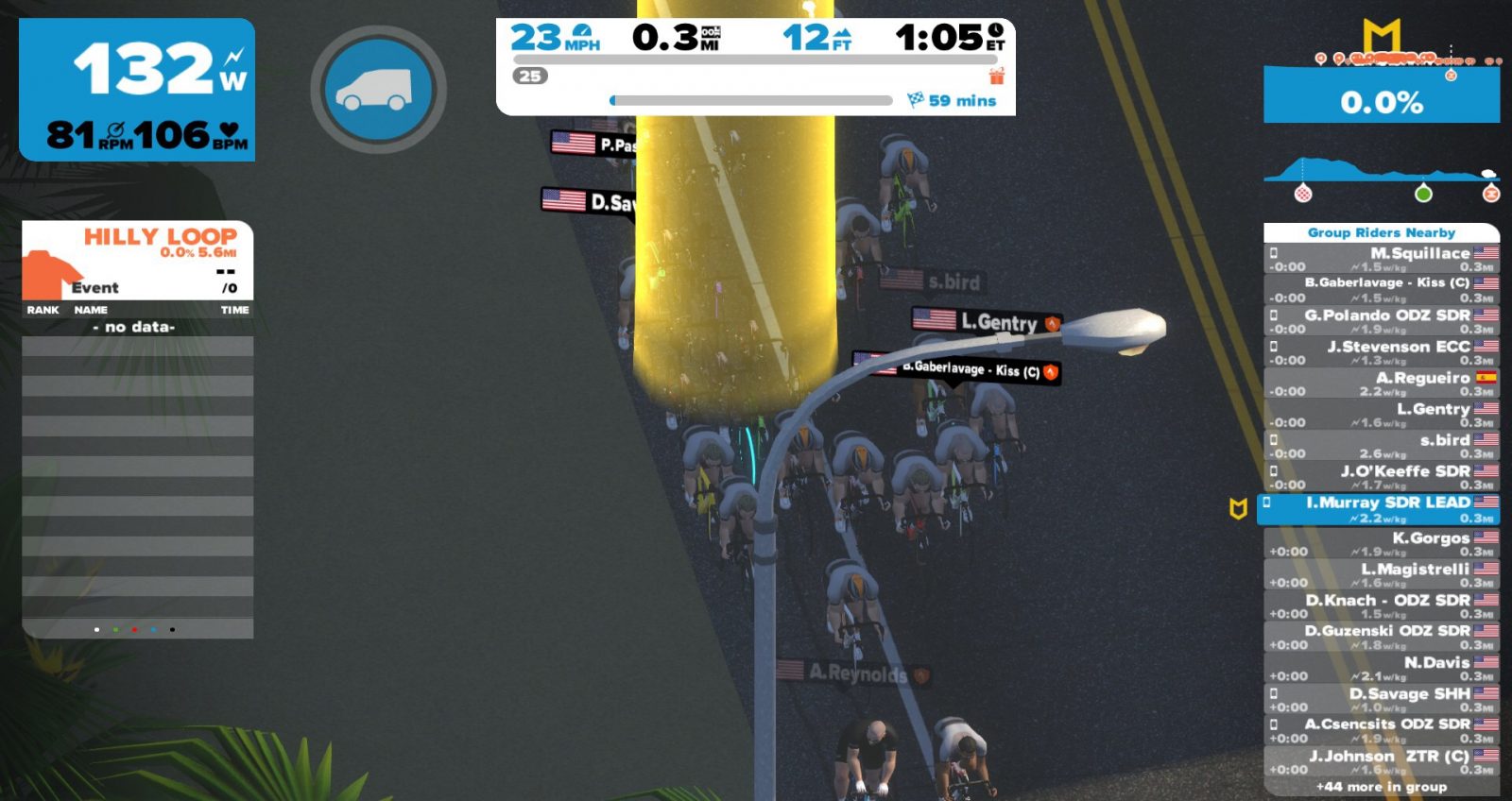Last week we discussed chasing as a group, so today we covered how to finish off your race from the small group. Sprinting from a small group is a different animal than sprinting from a large field with the help of teammates. In the small group, the smarter or more situationally-aware rider can sometimes outwit the stronger rider. At the end of the day, though, your legs have to still put out the power to get to the line first.
As usual, we started with our 1.5 W/kg warm-up and practiced moving around the bunch. After about ten minutes we got into class. Like I stated earlier, sprinting from a small group is different than a field sprint. In general, there are three types of moves that you can make in the final sprint: the cagey sprint, the high speed sprint, and the sprint from the front. During the class, we executed each two times to make sure everyone got the feel for the effort.
Cagey Sprint
 This is something everyone has watched in a small group, breakaway finish. The cagey sprint occurs when you put another rider on the front and use his or her slipstream to slingshot you around for your sprint. It is a surprisingly simple tactic, but everyone knows it is coming. To execute the cagey sprint, you have to keep working into the last kilometer or so. At that point, you have to make a concentrated effort to slow your effort rapidly, forcing the riders behind you to take the lead position, giving you an aerodynamic advantage. The difficult part will be staying off of the front as the riders on the front will not want to be there. That’s where the caginess comes into play. As the pace starts to wane, you have to make the determination of when to launch your sprint based on your fatigue, the terrain, and the wind. However, you have to be in the gear you desire to open your sprint. Otherwise, you could fall victim to the sprint off the front technique (we’ll cover that later). As you approach your identified launch point, let a small gap of a couple of meters open between you and the rider in front of you. Once the gap opens a bit, start the sprint and slingshot around the riders in front of you. Be careful to not launch to early because the other riders are sure to respond, and the advantage of surprise will be lost.
This is something everyone has watched in a small group, breakaway finish. The cagey sprint occurs when you put another rider on the front and use his or her slipstream to slingshot you around for your sprint. It is a surprisingly simple tactic, but everyone knows it is coming. To execute the cagey sprint, you have to keep working into the last kilometer or so. At that point, you have to make a concentrated effort to slow your effort rapidly, forcing the riders behind you to take the lead position, giving you an aerodynamic advantage. The difficult part will be staying off of the front as the riders on the front will not want to be there. That’s where the caginess comes into play. As the pace starts to wane, you have to make the determination of when to launch your sprint based on your fatigue, the terrain, and the wind. However, you have to be in the gear you desire to open your sprint. Otherwise, you could fall victim to the sprint off the front technique (we’ll cover that later). As you approach your identified launch point, let a small gap of a couple of meters open between you and the rider in front of you. Once the gap opens a bit, start the sprint and slingshot around the riders in front of you. Be careful to not launch to early because the other riders are sure to respond, and the advantage of surprise will be lost.
This type of sprint can be a bit longer than some, but you shouldn’t go from much more than 400 meters, or you risk fading in the last 50. I will caution you that this is an easier tactic to pull off on the road than on Zwift. Other riders can see your W/kg without putting themselves in danger, so the element of surprise is not as powerful of a tool. On the road, you have more options. You can go when all riders are looking forward or to the side away from where they look most often (most people have a preferred side). If they look right and you go left, you may be able to get an extra bike length or two before they process what just happened.
High Speed Sprint
Basically, you execute this sprint when the group you are in does not have a big enough gap for games. Thus, nobody can afford to let off the gas to try to put someone on the front, usually because the main field is charging up behind them. You see this periodically in rolling sprint stages at the Grand Tours towards the latter part of the three weeks. To execute this technique, you need to be in the first four wheels. Third wheel is preferred. Any further back than that, you will burn your max power just getting to the front and likely won’t have enough to hold off your group. From third or fourth wheel, let a small gap of two to three meters open, but no more. Shift up a gear or two if you can, dropping the cadence to the high 60s or low 70s. Use the small gap to build to max power. You need to be at max power as you come around the wheel in front of you, or you will not be able to break the draft. You will simply lead out the riders you just passed. Due to the speed that the group is already riding, you need to delay the sprint as long as possible to take advantage of your ten second power and hold off the group as the riders respond.
Fortunately, the group will probably shatter almost immediately under your attack, and there will likely not be any collaboration between individuals unless they are teammates. This technique is much easier to pull off in Zwift than in IRL racing. Jumping out into the headwind can just crush your motivation, and you will be too hypoxic and delirious from lactic acid to have a good understanding of how your competitors have reacted.
Sprint from the Front
 Of all three, this is the least likely to succeed unless you are simply way stronger than those behind you or have a teammate on your wheel who will let the gap open. There is no reason to want to do this technique unless you get put on the front and can’t get off of it. Try and try again to slow the pace and put someone else on the front. As you do so, watch the reactions of the other riders. If you can lull them into a pattern, they will start paying attention to those behind them and not to you. Be mindful that you need to start this process early, preferably well before the 1km to go banner. That way, you have a chance to get off the front or get them to think about other riders.
Of all three, this is the least likely to succeed unless you are simply way stronger than those behind you or have a teammate on your wheel who will let the gap open. There is no reason to want to do this technique unless you get put on the front and can’t get off of it. Try and try again to slow the pace and put someone else on the front. As you do so, watch the reactions of the other riders. If you can lull them into a pattern, they will start paying attention to those behind them and not to you. Be mindful that you need to start this process early, preferably well before the 1km to go banner. That way, you have a chance to get off the front or get them to think about other riders.
In live road racing, you can look at what the other riders are doing, and that will cue you in to how they might react. In Zwift racing, you can only watch their w/kg data and look to see if they stop pedaling when you slow down. If they do, that’s when you time your launch. Same goes for IRL racing. If the riders begin looking around, look back and ease off the pedals like you have done five or six times already. The key is to look back first. As soon as the second wheel turns his or her head, you go, and you go hard. In Zwift, you watch for that w/kg to begin to drop, then you go. If you do this from about 1km to go, you might get the group to hesitate, as it will have missed the opportunity to respond immediately. That hesitation is all you need. Settle into your one minute power and crush the last kilometer.
Conclusion
Now, these techniques are not fool-proof ways to win a race. Sometimes, you just get out-powered. Other riders also know these same techniques, so think of it as chess or poker. Try not to give away what you are doing, and always have a Plan B ready if the situation changes on you. Next time you find yourself in a small group at a race or group ride with the county line sprint, give one or more of these techniques a shot and let me know how it worked out for you.
Next week, we’ll be on Watopia Flat, and we’ll work on bridging. Expect some good strong but short efforts. Until then, RideOn!


